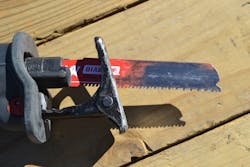University of Extrication: The “Gun Barrel” Boron Pipe—Part 2
Subject: Ultra-High-Strength Steel
Topic: The “Gun Barrel” Boron Pipe, Part 2
Objective: Understanding the challenges of ultra-high-strength steel in vehicles
Task: Given a 2003–2011 Volkswagen Beetle convertible, the rescue team shall use cutting tools to sever the “Gun Barrel” Boron steel pipe found inside both A pillars.
In Part 1 of our look at the ultra-high-strength steel “Gun Barrel” pipe in the new Volkswagen (VW) Beetle convertible, we learned the location of the thick-walled pipe and how difficult it can be to cut. In this article, we’ll reveal how rescuers can cut through the pipe, as well as the pillar that contains it, and the lessons learned during this research project.
Cutters vs. the gun barrel
The VW Beetle A pillars include not only a 1 3/8"-diameter boron pipe, but also a layer of boron steel inside. Research was conducted to determine what tools and methods are available to cut through this Gun-Barrel Boron steel pipe.
I tested several of the newest and most powerful rescue cutters against the gun barrel pipe and all stalled during their cutting effort. Specifically, they easily cut through the single layer of Boron inside the pillar, but found the thick Gun Barrel pipe to be too thick to get through. In fact, during the evaluations, one power cutter had a catastrophic blade failure while a second cutter suffered significant damage to the cutting edges of its blades. But none of this is surprising since the Gun Barrel pipe is, as you know, a formidable obstacle.
The saws that made the cut
After finding that a standard power cutter couldn’t cut through the pipe, my research turned to evaluating a variety of reciprocating saw blades. Of all the brands tested, only two successfully cut through the pipe, and did so most efficiently and effectively when I decreased the saw blade speed to 1,250–1,500 strokes per minute, which is a low to medium speed setting on most variable speed saws. In short, slower speed yielded noticeably better results.
The first blade to cut through the Gun Barrel pipe was the Bosch- S1136 BEF blade, which features a variable 14–18 tooth-per-inch design. Cutting time averaged almost three minutes, which was exhausting. The endeavor was hard on the saw as well, as the blade had to be replaced after each cut.
The second blade that cut through the pipe performed better. It was a Diablo DS0608 CF blade with an 8 tooth-per-inch design. The relatively inexpensive, carbide-tipped blade, commercially available at a large-box retail store, was able to cut through the pipe in 60 seconds or less. Saw speed remained at the low-to-medium setting and the physical effort made by the rescuer was significantly less than the first round.
What made the difference? Management of the saw’s shoe made more of the Diablo blade’s teeth available to cut the Boron. Starting with the shoe extended, the teeth were set further out on the blade, which actually allowed me to make more cuts through the A-pillar and the Gun Barrel pipe. Once those teeth became worn, the shoe was retracted and fresh teeth, closer to the base of the blade, made even more cuts.
Lessons learned
Lessons learned during this project included having a responder who’s disciplined enough to maintain good saw control. Remember: The only thing that should reciprocate back and forth is the blade, not the operator or the saw.
The “best practice” of slowing down the saw blade from maximum speed to a medium or moderate speed setting increased the blade’s cutting life, made the cutting more effective and lessened the physical strain on the rescuer.
In addition, effective management of the saw’s shoe—starting with the shoe extended, then retracting it to expose fresh teeth on the blade—was an effective means of extending the cutting life of each blade.
The result of all of these reciprocating saw “best practices” allowed the 6" Diablo blade with the saw set on low to medium stroke speed, to cut through the Boron steel Gun Barrel A-pillar pipe a total of five times before it finally had to be taken out of service.
About the Author
Ron Moore
RON MOORE, who is a Firehouse contributing editor, recently retired as a division chief with the McKinney, TX, Fire Department and now serves with Prosper, TX, Fire Rescue. He self-published the Vehicle Rescue 1-2-3 training manual and serves as the forum moderator for the extrication section of Firehouse.com . Moore can be contacted directly at [email protected].

